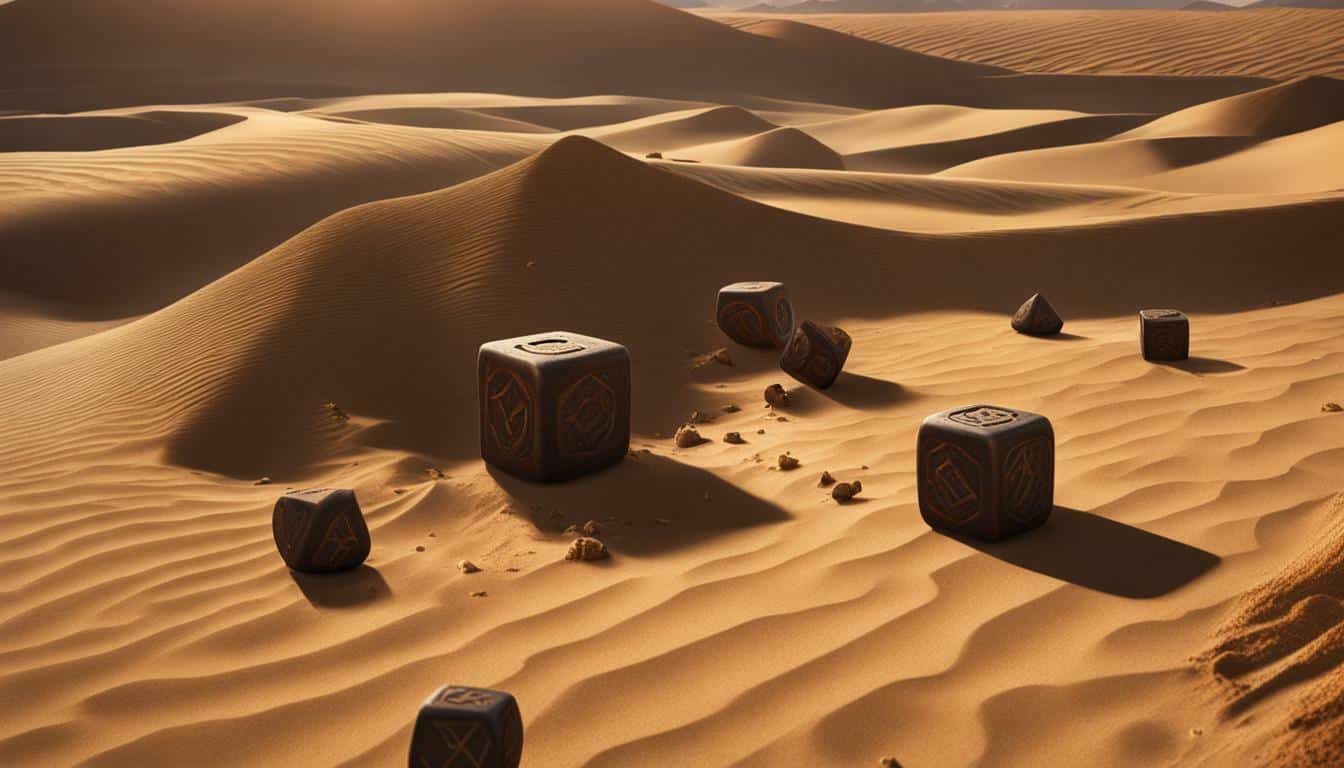Dice have been an integral part of human culture for thousands of years, but their origins remain shrouded in mystery. Historians believe that early iterations of dice were used in various forms across different cultures around the world.
Some of the earliest known dice were discovered in Mesopotamia (present-day Iraq) and date back to around 3000 BCE. These dice were made from animal bones and were used for divination purposes. Similar dice have also been found in ancient Egypt and Greece, where they were used in religious rituals and for gambling.
Over time, dice evolved and became more standardized, with the familiar cube shape we know today emerging during the Middle Ages. Today, dice continue to be popular in various games and gambling activities across the world.
Key Takeaways:
- Dice have been a part of human culture for thousands of years
- Early dice were made from animal bones and used for divination purposes
- Dice have been used in religious rituals and gambling throughout history
- The cube shape of dice emerged during the Middle Ages
- Dice continue to be popular in games and gambling activities today
Ancient Dice: A Glimpse into the Past
The use of dice goes back thousands of years, making them one of the oldest gaming implements in history. The earliest known dice were made from natural materials, such as bones, stones, and shells. These early dice had irregular shapes and were often marked with symbols or numbers to indicate their value.
The history of dice is a long and fascinating journey, and it’s difficult to pin down an exact timeline. However, it’s believed that the ancient Egyptians were one of the first civilizations to use dice in a game of chance. They used dice made from ivory and bone, and they even had a game that closely resembled modern-day backgammon.
Around 600 BCE, the Greeks began using dice in their games, and they were often made from bronze or lead. The Romans also used dice extensively for gambling and games. They had a game called “Duodecim Scripta,” which was similar to backgammon, and they used dice that were marked with symbols and numbers.
As time passed, dice continued to evolve. By the Middle Ages, dice were often made from animal bones, and they had a standardized shape and size. The dots or pips on the dice became more uniform, and the modern six-sided die began to emerge.
| Time Period | Dice Material | Dice Shape and Design |
|---|---|---|
| Ancient Egypt | Ivory and bone | Irregular shape, marked with symbols or numbers |
| Ancient Greece | Bronze or lead | Irregular shape, marked with symbols or numbers |
| Ancient Rome | Bone or ivory | Cubical shape, marked with symbols or numbers |
| Middle Ages | Animal bones | Standardized cubical shape, uniform dots or pips |
Today, dice come in many forms and are used for a variety of purposes. They’re commonly used in board games, RPGs, and gambling, and they can be made from a range of materials, including plastic, metal, and even glass. The history of dice is a testament to their enduring appeal and their ability to adapt and evolve over time.
The Evolution of Dice: From Bones to Cubes
Dice have undergone a remarkable evolution throughout history. From early origins made from natural materials such as bones to the standardized shapes and symbols we know today, dice have come a long way.
The earliest known dice were made from bones, ivory, or stone. These early dice were often irregular in shape and size, with markings that were etched or painted onto the surface. As civilizations advanced, so did the materials used to create dice. Ancient Egyptians carved dice from wood or faience, while Greeks and Romans used precious metals like bronze and gold to create their dice.
It wasn’t until the invention of modern dice that we saw the emergence of the familiar cube shape. In the early 20th century, dice manufacturers began producing dice with standardized shapes and sizes, making them easier to roll and ensuring fairness in games.
The modern dice we know today are typically made from plastic or resin and feature numbered dots or pips on each side. The dots are arranged in a specific pattern that ensures randomness when rolled. This innovation has revolutionized games and gambling, making it easier to determine the outcome of each roll.
In addition to standard dice, there are also specialized dice used for specific games or activities. These can include dice with more than six sides, called polyhedral dice, and dice with symbols or pictures instead of numbers. There are also loaded dice, which are unfairly weighted to increase the chances of rolling a specific number, and casino-grade dice, which are precisely manufactured to ensure they are fair and unbiased.
The evolution of dice has allowed for more fair and enjoyable games, while also providing opportunities for new games to be created. The invention of modern dice has had a significant impact on the world of gaming and gambling, and their continued evolution and innovation will undoubtedly bring new possibilities and opportunities in the future.
Baccarat Side Bets Explained: Beginner’s Guide to Winning More
Dice in Ancient Civilizations: A Game of Chance
Dice have been used for thousands of years, and ancient civilizations were no exception. The origins of dice in ancient civilizations can be traced back to Ancient Egypt, Greece, and Rome. Dice were used for religious rituals, gambling, and games of chance.
Ancient Egyptians used dice for religious purposes, believing that the outcome of the roll could determine the will of the gods. Greeks and Romans, on the other hand, used dice primarily for gambling and entertainment.
The cultural significance of dice in ancient civilizations cannot be understated. Dice games were often used as a form of social interaction and were deeply rooted in the society of the time. The games were often seen as a symbol of chance and luck, and winning or losing could have a significant impact on the player’s social status.
Interestingly, the dice used in ancient civilizations were not always the familiar cube shape we know today. Early dice were made from a variety of materials, including bones, stones, and even fruit pits. The shapes and designs of the dice varied depending on the time period and the materials available.
Some ancient civilizations also used dice in board games. These games were often played by the upper classes and were seen as a sign of wealth and sophistication. Board games such as senet and ludus latrunculorum were popular in Ancient Egypt and Rome, respectively.
Overall, the history of dice in ancient civilizations is a testament to the enduring popularity of this game of chance. The cultural significance of dice and their impact on society is a fascinating topic that continues to captivate us to this day.
Dice in Modern Times: From Gambling to Board Games
The history of dice dates back thousands of years, and their use has evolved over time. Dice have played a significant role in various aspects of human culture, from religious rituals, gambling, to board games. Let’s take a closer look at the modern use of dice.
One of the most common uses of dice in modern times is gambling. Casinos across the world offer games that utilize dice, such as craps. The game involves players betting on the outcome of a roll, and it has been popular in casinos for centuries. The history of dice and gambling is intertwined, and it’s fascinating to see how they have evolved together throughout history.
Another popular use of dice is in board games. Many classic board games, such as Monopoly and Yahtzee, incorporate dice as a crucial component. The roll of the dice adds an element of chance and unpredictability to these games, making them more exciting and engaging for players.
Dice games have also had a significant cultural impact. They have been the subject of art pieces, literature, and even films. The cultural significance of dice is a testament to their enduring popularity and importance in human society.
Understanding the history of dice and their evolution provides us with a deeper appreciation for these timeless objects. The role of dice in gambling and board games, as well as their cultural impact, continues to make them relevant in modern times. The history of dice is an exciting journey that demonstrates how even the simplest objects can have a significant impact on human culture.
Conclusion
In conclusion, the history of dice is a captivating journey that spans thousands of years. We have delved into the origins of dice and traced their evolution through time. From ancient civilizations to modern times, dice have played a significant role in various aspects of human culture.
Cultural significance of dice
Dice have been used in religious rituals, gambling, and games of chance in various cultures throughout history. In ancient Egypt, dice were used to predict the future, while the ancient Greeks and Romans used dice for gambling and games.
The cultural impact of dice games can still be felt today, with the popularity of board games like Monopoly, which heavily rely on dice rolls. Additionally, dice games like craps and Yahtzee remain popular in casinos and homes alike.
The evolution of dice
The evolution of dice throughout history has been fascinating. Dice were originally made from natural materials such as bones, shells, and pebbles. Over time, dice evolved into the familiar cube shape we know today, with standardized shapes and symbols.
The invention of modern dice, made from synthetic materials like plastic, has revolutionized the gaming industry. These dice are more durable and offer a wide variety of designs and colors.
The timeless game of chance
Understanding the origins of dice provides us with a deeper appreciation for this timeless game of chance. From ancient civilizations to modern times, dice have been a source of entertainment and fortune.
The history of dice is a testament to the human desire for leisure and excitement. Whether you are playing a board game with friends or rolling dice in a casino, the thrill of chance is an exhilarating experience that has stood the test of time.
FAQ
Discovering the Origins: Where Did Dice Come From?
In this section, we will delve into the captivating history of dice and explore their origins. We will uncover the origins of dice and trace their evolution through time.
Ancient Dice: A Glimpse into the Past
Let’s take a closer look at the early origins of dice and discover how they were used in ancient civilizations. We will explore the timeline of dice history and learn about the different materials and designs used in ancient dice.
The Evolution of Dice: From Bones to Cubes
This section will focus on the evolution of dice throughout history. We will examine how dice transformed from natural materials such as bones to the familiar cube shape we know today. We will also discuss the invention of modern dice and the introduction of standardized shapes and symbols.
Dice in Ancient Civilizations: A Game of Chance
Explore the role of dice in ancient civilizations, such as Ancient Egypt, Greece, and Rome. Discover how dice were used in religious rituals, gambling, and games of chance. We will uncover the cultural significance of dice and their impact on society during these times.
Dice in Modern Times: From Gambling to Board Games
This section will dive into the role of dice in modern times. We will examine how dice have been used in gambling and how they have influenced the development of board games. We will also discuss the cultural impact of dice games and their continued popularity in today’s society.
Conclusion
In conclusion, the history of dice is a fascinating journey that stretches back thousands of years. From ancient civilizations to modern times, dice have evolved and played a significant role in various aspects of human culture. Understanding the origins of dice provides us with a deeper appreciation for this timeless game of chance.








Leave a Review